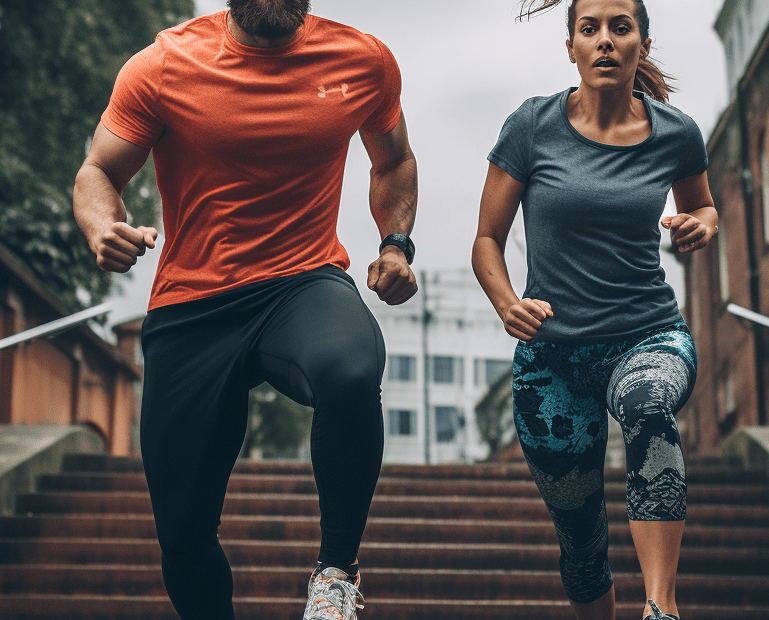
Image created by: Joao Almeida(Midjourney)
The 20-Minute Fat-Burning Workout: Fat-Burning Workout
Introduction
In the realm of fitness, there’s a common misconception that effective workouts require hours of dedication, expensive equipment, and a gym membership. However, the truth is that with the right approach, even a short 20-minute workout can yield significant results. The 20-minute fat-burning workout is a testament to this, offering a comprehensive routine that can be done anywhere, anytime.
The Science Behind Short, Intense Workouts
High-Intensity Interval Training (HIIT) has gained immense popularity in recent years, and for a good reason. Studies have shown that short bursts of intense exercise, followed by brief rest periods, can be as effective, if not more so, than prolonged, moderate workouts. The reason? HIIT workouts push the body into the anaerobic zone, where it burns more calories in less time and continues to do so even after the workout is over, a phenomenon known as the afterburn effect or excess post-exercise oxygen consumption (EPOC).
The 20-Minute Anywhere Fat-Burning Workout Detailed
This workout is designed to be adaptable, ensuring that whether you’re in a cramped hotel room, a spacious park, or your living room, you can get your heart racing and muscles working.
Before diving into any workout, it’s crucial to prepare your body adequately. Warm-up exercises are not just a preliminary routine; they are foundational steps that set the tone for the entire workout. Among the most effective warm-up exercises are Jumping Jacks and Dynamic Stretching. Let’s delve deeper into these exercises and understand their importance.
Warm-Up (3 minutes)
Start with Jumping Jacks for one minute. This classic exercise gets the blood flowing and muscles warmed up. Follow it up with Dynamic Stretching for two minutes, incorporating movements like leg swings, arm circles, and torso twists.
Jumping Jacks: The Cardio Kickstart (1 minute)
Jumping Jacks are a classic calisthenic exercise that has stood the test of time. Here’s why they are an excellent choice for warming up:
- Cardiovascular Boost: Jumping Jacks are a full-body movement that quickly elevates the heart rate. Within a minute, you can feel your heart pumping faster, ensuring that blood is efficiently circulated to all parts of the body.
- Muscle Activation: The exercise engages multiple muscle groups, including the legs, core, and arms. This ensures that these muscles are activated and ready for more targeted exercises later in the workout.
- Flexibility and Coordination: The synchronized movement of the arms and legs improves body coordination. Additionally, the continuous jumping motion enhances flexibility in the leg muscles.
How to Perform: Stand with your feet together and arms by your side. Jump while spreading your legs shoulder-width apart and simultaneously raising your arms above your head. Return to the starting position and repeat.
Dynamic Stretching: Loosening Up for Action (2 minutes)
Dynamic Stretching differs from traditional static stretching. Instead of holding a stretch for an extended period, dynamic stretching involves moving parts of your body and gradually increasing reach, speed, or both.
- Leg Swings: This exercise targets the hamstrings, quadriceps, and hip flexors. Hold onto a support, swing one leg forward and backward in a controlled motion. After several swings, switch to the other leg.
- Arm Circles: Perfect for warming up the shoulders, biceps, and triceps. Extend your arms out to the side and make small circular motions, gradually increasing the circle’s diameter. After a few seconds, reverse the direction of the circles.
- Torso Twists: Engage the core, obliques, and lower back with this exercise. Stand with your feet shoulder-width apart and twist your torso to the left and then to the right. Ensure the movement is controlled and originates from the waist.
Benefits of Dynamic Stretching:
- Increases Blood Flow: The movements enhance circulation, ensuring that muscles receive adequate oxygen and nutrients.
- Improves Range of Motion: Regular dynamic stretching can enhance your joints’ range of motion, making it easier to perform exercises and daily activities.
- Mental Preparation: The act of dynamic stretching allows you to focus on the upcoming workout, mentally preparing you for the session ahead.
Conclusion
Warm-up exercises like Jumping Jacks and Dynamic Stretching are not just preliminary steps but are crucial for a safe and effective workout. They ensure that the body is prepared, both physically and mentally, for the challenges ahead. So, the next time you’re gearing up for a workout, don’t skip these essential steps.
Main Workout (15 minutes)
The core of this workout is a series of high-intensity exercises interspersed with rest periods. Begin with Burpees for one minute. This full-body movement engages almost every muscle and is excellent for cardiovascular health. After a 30-second rest, move on to Push-Ups for one minute. This targets the upper body, especially the chest, shoulders, and triceps. Continue this pattern of exercise and rest with Squats, Mountain Climbers, Lunges, Plank, High Knees, Tricep Dips, and Jump Squats.
Bodyweight exercises are the cornerstone of many fitness routines. They require no equipment, can be done anywhere, and offer a full-body workout. Among the most effective and versatile bodyweight exercises are Squats, Mountain Climbers, Lunges, Plank, High Knees, Tricep Dips, and Jump Squats. Let’s delve into each of these exercises, exploring their techniques and benefits.
Squats: The Foundation of Lower Body Strength
Squats primarily target the quadriceps, hamstrings, and glutes. They also engage the core, making them a comprehensive lower body exercise.
How to Perform: Stand with feet shoulder-width apart. Keeping your back straight, lower your body as if sitting in a chair until your thighs are parallel to the ground. Push through your heels to return to the starting position.
Benefits: Enhances leg strength, improves balance, and boosts flexibility in the hips.
Mountain Climbers: Cardio Meets Core Strength
Mountain Climbers are a dynamic exercise that combines cardiovascular training with core engagement.
How to Perform: Start in a plank position. Bring one knee towards the chest and then quickly switch to the other knee, mimicking a running motion.
Benefits: Elevates heart rate, strengthens the core, and enhances shoulder stability.
Lunges: Targeted Leg Toning
Lunges focus on the quadriceps, hamstrings, and glutes, offering a targeted workout for each leg.
How to Perform: From a standing position, take a step forward with one leg and lower your body until both knees are bent at a 90-degree angle. Push back to the starting position and switch legs.
Benefits: Improves leg strength, enhances balance, and aids in hip flexibility.
Plank: The Ultimate Core Challenge
Plank is a static exercise that engages the entire core, including the rectus abdominis, obliques, and lower back.
How to Perform: Start in a push-up position but with weight on your forearms. Keep your body in a straight line from head to heels.
Benefits: Strengthens the core, enhances shoulder stability, and improves posture.
High Knees: Cardio Burst
High Knees are a cardiovascular exercise that also engages the core.
How to Perform: Standing upright, quickly bring one knee up towards the chest and then switch to the other knee, mimicking a running motion.
Benefits: Elevates heart rate, improves coordination, and strengthens the hip flexors.
Tricep Dips: Arm Toning Made Simple
Tricep Dips target the triceps, the muscles at the back of the upper arm.
How to Perform: Using a bench or chair, place your hands shoulder-width apart. Extend your legs out in front. Lower your body by bending your elbows until they’re at a 90-degree angle, then push back up.
Benefits: Strengthens the triceps and enhances upper body stability.
Jump Squats: Power and Plyometrics
Jump Squats add an explosive element to the traditional squat, incorporating plyometric training.
How to Perform: Start in a squat position. Explosively jump upwards, extending your legs and reaching for the sky. Land softly and immediately go into the next squat.
Benefits: Boosts leg power, elevates heart rate, and improves athletic performance.
Conclusion
Bodyweight exercises like Squats, Mountain Climbers, and Lunges offer a versatile and effective workout option. Whether you’re at home, in a park, or traveling, these exercises ensure you can maintain your fitness routine. Incorporate them into your regimen and witness the transformative power of foundational movements.
Cool Down (2 minutes)
After the intense session, it’s crucial to bring your heart rate down gradually. Start with Deep Breathing for one minute, inhaling deeply through the nose and exhaling through the mouth. Finish off with Static Stretching for one minute, focusing on the major muscle groups you’ve engaged.
Adapting the Workout to Your Needs
The beauty of this workout lies in its adaptability. If you’re a beginner, you might want to reduce the duration of each exercise and increase the rest period. Conversely, if you’re more advanced, consider adding more reps, sets, or even incorporating weights if available.
The Benefits of the 20-Minute Workout
- Time-Efficient: In just 20 minutes, you can achieve what might take an hour or more in a traditional workout setting.
- Cost-Effective: No need for gym memberships or fancy equipment.
- Versatile: Can be done anywhere, making it perfect for travelers or those with busy schedules.
- Holistic: Engages multiple muscle groups, ensuring a balanced workout.
FAQs
- How often should I do this workout?
For optimal results, aim to do this workout 3-4 times a week, ensuring you have rest days in between for muscle recovery. - Can I combine this with other exercises?
Absolutely! This workout can be a part of a broader fitness regimen, or it can be your primary routine, depending on your goals. - Is it suitable for all age groups?
While the workout is adaptable, it’s always a good idea to consult with a healthcare professional or fitness expert, especially if you have existing health conditions.
Conclusion
The 20-minute fat-burning workout is more than just a quick fitness routine; it’s a testament to the efficiency and adaptability of HIIT workouts. Whether you’re a seasoned athlete or someone just starting their fitness journey, this workout offers a comprehensive, effective, and versatile way to stay fit, no matter where you are.

